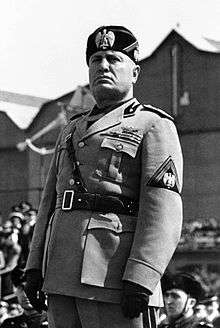Italian general election, 1934
| | ||||||||||||||||||||||||||||||||||||||
| ||||||||||||||||||||||||||||||||||||||
| ||||||||||||||||||||||||||||||||||||||
| ||||||||||||||||||||||||||||||||||||||
General elections were held in Italy on 26 March 1934. Following a parliamentary reform enacted in 1928 by the Chamber of Deputies and Senate, the elections were held in the form of a referendum, with the Grand Council of the National Fascist Party, now an official state organ, allowed to compose a single party list to be either approved or rejected by the voters. The list put forward was ultimately approved by 99.84% of voters.[1] The overwhelming majority provoked Benito Mussolini to dub the election the "second referendum of Fascism."
Electoral system
As for 1929 election, the universal male suffrage was restricted only to men who were members of a trade union or an association, to soldiers and to members of the clergy; and for this only 9,5 million of people were admitted to vote.
The election took place in a plebiscite form; voters could vote "Yes" or "No" to approve the list of deputies appointed by the Grand Council of Fascism. The voter was equipped with two equal-sized sheets, white outside, inside bearing the words "Do you approved the list of members appointed by the Grand National Council of Fascism?" The electoral paper with the "Yes" was also accompanied by the Italian tricolour and a fasces, the "No" one was only a white paper without any symbol.
The voter must vote at the time of collecting both cards; inside the voting booth was a first ballot box where the voter left the discarded card and then deliver to the scrutineers chosen paper, so that they would ensure that it was "carefully sealed". This process did not assure that the vote was really secret.
Moreover, if the "No" would win, the election had to be repeated, with the ammission of other electoral lists.[2]
Historical background

In 1929, a concordat with the Vatican was signed, ending decades of struggle between the Italian state and the Papacy that dated back to the 1870 takeover of the Papal States by the House of Savoy during the unification of Italy. The Lateran treaties, by which the Italian state was at last recognized by the Roman Catholic Church, and the independence of Vatican City was recognized by the Italian state, was so much appreciated by the ecclesiastic hierarchy that Pope Pius XI acclaimed Mussolini as "the Man of Providence".[3]
During 1930s Mussolini also lead the armed local fascist militia, the MVSN or "Blackshirts", who terrorized incipient resistances in the cities and provinces and established the OVRA, an institutionalized secret police that carried official state support. In this way he succeeded in keeping power in his own hands and preventing the emergence of any rival.
After Adolf Hitler came into power, threatening Italian interests in Austria and the Danube basin, Mussolini proposed the Four Power Pact with Britain, France and Germany in 1933. When the Austrian 'austro-fascist' Chancellor Engelbert Dollfuss with dictatorial power was assassinated on 25 July 1934, by National-Socialist supporters, Mussolini even threatened Germany with war in the event of a German invasion of Austria. Mussolini for a period of time continued strictly opposing any German attempt to obtain Anschluss and promoted the ephemeral Stresa Front against Germany in 1935.
Results

 | |||||
| Choice | Votes | % | Seats | +/− | |
|---|---|---|---|---|---|
| National Fascist Party | 10,043,875 | 99.85 | 400 | ±0 | |
| Against | 15,215 | 0.15 | 0 | ±0 | |
| Invalid/blank votes | 1,300 | – | – | – | |
| Total | 10,059,090 | 100 | 400 | ±0 | |
| Registered voters/turnout | 10,527,608 | 95.56 | – | – | |
| Source: Direct Democracy | |||||
References
- ↑ Italy, 24 May 1929: Fascist single list Direct Democracy (German)
- ↑ Testo Unico 2 settembre 1928, n. 1993
- ↑ Fattorini, Emma (2011). Hitler, Mussolini and the Vatican : Pope Pius XI and the speech that was never made ([English ed.] ed.). Cambridge, UK: Polity Press. p. xi. ISBN 978-0-7456-4488-2.
